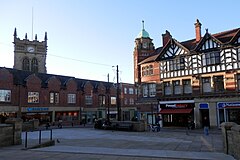
Back Wigan Afrikaans ويغان Arabic ويجان ARZ Уіган Byelorussian Уигън Bulgarian Wigan Breton Wigan Catalan Wigan (kapital sa kondado sa Hiniusang Gingharian) CEB Wigan Czech Wigan Welsh
| Wigan | |
|---|---|
| Town | |
 Market Place, Wigan | |
Location within Greater Manchester | |
| Population | 107,732 (2011 Census) |
| OS grid reference | SD583055 |
| • London | 176 miles (283 km) SE |
| Metropolitan borough | |
| Metropolitan county | |
| Region | |
| Country | England |
| Sovereign state | United Kingdom |
| Post town | WIGAN |
| Postcode district | WN1-WN3, WN5, WN6 |
| Dialling code | 01942 |
| Police | Greater Manchester |
| Fire | Greater Manchester |
| Ambulance | North West |
| UK Parliament | |
Wigan (/ˈwɪɡən/ WIG-ən) is a town in Greater Manchester, England, on the River Douglas. The town is midway between the two cities of Manchester, 16 miles (25.7 km) to the south-east, and Liverpool, 17 miles (27 km) to the south-west. Bolton lies 10 miles (16 km) to the north-east and Warrington 12 miles (19 km) to the south. It is the largest settlement in the Metropolitan Borough of Wigan and is its administrative centre. The town has a population of 107,732[1] and the wider borough of 330,714.[2] Wigan is part of the historic county of Lancashire.
Wigan was in the territory of the Brigantes, an ancient Celtic tribe that ruled much of what is now Northern England. The Brigantes were subjugated in the Roman conquest of Britain and the Roman settlement of Coccium was established where Wigan lies. Wigan was incorporated as a borough in 1246, following the issue of a charter by King Henry III of England. At the end of the Middle Ages, it was one of four boroughs in Lancashire established by royal charter. The Industrial Revolution saw a dramatic economic expansion and rapid rise in population. Wigan became a major mill town and coal mining district; at its peak, there were 1,000 pit shafts within 5 miles (8 km) of the town centre.[3][4] Coal mining ceased in the later 20th century.
Wigan Pier, a wharf on the Leeds and Liverpool Canal, was made famous by the writer George Orwell. In his book The Road to Wigan Pier (1937), Orwell highlighted the poor working and living conditions of inhabitants in the 1930s. Following the decline of heavy industry, Wigan Pier's warehouses and wharves became a local heritage centre and cultural quarter. The DW Stadium is home to Wigan Athletic Football Club and Wigan Warriors Rugby League Football Club.
- ^ "Understanding towns in England and Wales: population and demography - Office for National Statistics". www.ons.gov.uk.
- ^ "Mid-Year Population Estimates, UK, June 2022". Office for National Statistics. 26 March 2024. Retrieved 3 May 2024.
- ^ Frangopulo 1977, p. 139.
- ^ Wigan County Borough Council (1972), The County Borough of Wigan: Official Handbook
© MMXXIII Rich X Search. We shall prevail. All rights reserved. Rich X Search
